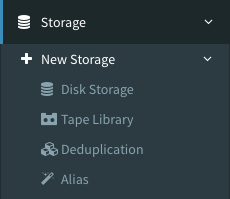Defining a new backup Storage - inteos/IBAdmin GitHub Wiki
IBAdmin

Defining a new backup Storage
To define a new backup storage you should select Storage -> New Storage at the left sidebar.

Then you can define a four types of backup storage:
Note: The current implementation support configuration and management of a local storage only. This limitation will be removed in future releases.
*) Deduplication option is available for Bacula Enterprise Edition with Global Endpoint Deduplication Plugin installed only. All Inteos Backup customers have access to this functionality by default.
Disk Storage
This is a standard Bacula virtual disk autochanger configuration where all data is stored as a standard files in configured directory. To define a new disk storage you have to input its name which should be unique in the system (you will get an error if it is not), description (optional), select existing storage daemon to configure and input an archive directory where all volumes will be stored (the directory has to already exist on server before storage could be defined). This kind of storage will have a "FileN" MediaType defined, where 'N' is a storage id number.
Tape Library
This is a standard Bacula tape library configuration which will be autodetected and configured with IBAdmin. To define a new tape library storage you have to input its name which should be unique in the system (you will get an error if it is not), description (optional), select existing storage daemon to configure and select a library you want to configure from a list of available libraries. When all input data is valid then you can autodetect library configuration with Detect Library button. The autodetection will check what OS device belong to configured library and what library configuration it should apply for proper operations. Autodetection operation will load/unload a tape cartridge from every tape drive found on system and could take a long time. If autodetection succeed you'll be able to save your configuration. This kind of storage will have a "TapeN" MediaType defined, where 'N' is a storage id number.
Note: You have to load at least one tape cartridge into your library to make a proper autodetection. No tape will be (re)written during this test.
Deduplication Storage
This storage is similar to standard disk storage described above but additionally uses a deduplication engine to save data from backup drastically improving storage space used for backups and backup times. You can get more information about Bacula deduplication in available documentation. To define a new deduplication storage you have to input its name which should be unique in the system (you will get an error if it is not), description (optional), select existing storage daemon to configure, input a deduplication index directory (where deduplication index database will be stored, the directory has to already exist on server before storage could be defined) and a deduplication archive directory where all deduplication data containers and volumes will be stored (the directory has to already exist on server before storage could be defined). This kind of storage will have a "DedupN" MediaType defined, where 'N' is a storage id number.
Alias
This is a virtual storage configuration which points to a standard storage of any kind. This storage will inherit all its attributes from a storage where it points to, especially MediaType and volumes location (Archive Directory). To define a new alias storage you have to input its name which should be unique in the system (you will get an error if it is not), description (optional), select an existing storage of any kind except other storage aliases from a list and assign it IP address from a list of available addresses.
When you will be ready you should +Add the client to your configuration or Cancel the operation.